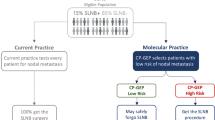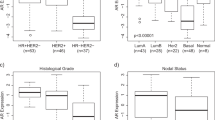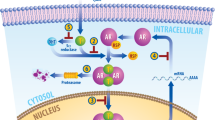Abstract
Metastatic lesions to the skin may present a dilemma in the identification of the primary site. Breast carcinoma, metastatic to the skin, that is negative for estrogen receptors (ERs) and/or progesterone receptors (PRs) may be mimicked by a number of other metastatic lesions. In the present study, 16 formalin-fixed and paraffin-embedded infiltrating ductal carcinomas metastatic to the skin, which were ER−/PR−, ER−/PR+, or ER+/PR−; 5 metastatic lesions to the skin from primary lesions other than breast cancer; and 5 eccrine tumors were examined for immunoreactivity to the androgen receptor. The majority of the metastatic breast lesions (82%) exhibited immunopositivity for androgen receptor, whereas the metastatic skin lesions from primary lesions other than breast cancer and the eccrine tumors were immunonegative. Thus, androgen receptor immunohistochemistry could serve as a marker to increase sensitivity for identifying breast cancer in skin metastasis of unknown primary sites.
Similar content being viewed by others
INTRODUCTION
In the examination of metastatic tumors to the skin, the identification of the site of the primary tumor is of importance as some carcinomas first come to the attention of the pathologist as skin metastases. Schwartz (1) found that 7.6% of carcinomas were first identified as skin metastases. In breast cancer metastases, presence of estrogen receptors (ERs) and progesterone receptors (PRs), identified by immunohistochemical stains, may aid in the identification of the primary site; however, eccrine neoplasms have also been shown to express ERs and PRs (2). Are there any additional clues to help one narrow the diagnosis to that of a metastatic breast lesion? It has been reported that in primary breast tumors, between 80% (3, 4) and 100% (5) of lesions are androgen receptor (AR) positive and 60% are positive for ARs, ERs, and PRs (6), whereas 25% of metastatic breast lesions are solely AR+ (7). ER, PR, and AR concentrations are lower in metastases than in the primary tumors (7, 8); of the three, ARs seem to be best preserved in metastases (3). Little is known about the role and clinical significance of AR in the biologic behavior of breast cancer (3), and even less is known about AR status in breast carcinomas that are metastatic to the skin. The discovery of a new antibody corresponding to amino acids 299 through 315 of the human AR presented the opportunity to assess the immunoreactivity of breast cancer metastases to the skin. Accordingly, this study was undertaken to assess the AR status of these neoplasms and to determine whether AR immunohistochemistry could serve as a marker to increase sensitivity for identifying breast cancer in skin metastasis of unknown primary site.
MATERIALS AND METHODS
A total of 21 biopsies of carcinomas, metastatic to the skin, and 5 primary eccrine tumors were obtained from the pathology tissue files at the University of Arkansas for Medical Sciences. The neoplasms were 16 metastatic infiltrating ductal breast carcinomas; 2 metastatic squamous cell carcinomas; 1 metastatic gastric carcinoma; 1 metastatic ovarian carcinoma; 1 metastatic melanoma; 1 eccrine acrospiroma; 2 eccrine poromas; and 2 syringomas, 1 of which was the clear cell variant. The specimens were fixed in 10% formalin and embedded in paraffin. Four-micron-thick sections were cut and mounted on 3-aminopropyltrethoxy-silane–coated slides, dried, and deparaffinized before undergoing antigen retrieval by heat treatment in DAKO Target Retrieval solution (DAKO, Carpenteria, CA). The endogenous peroxidase activity was quenched with prediluted peroxidase block, and nonspecific binding was quenched with horse serum block. The Immunocruz Staining System @ (Santa Cruz Biotechnology Inc., Santa Cruz, CA) was used with AR (441) as the primary prediluted antibody, a mouse monoclonal IgG1 antibody corresponding to amino acids 299 through 315 of the human AR. Sections were incubated for 2 h with the primary antibody and subsequently incubated with the biotinylated secondary antibody for 30 min. The signal was visualized with 3,3′-diaminobenzidine in chromogen solution with Imidazole-HCl buffer at pH 7.5 (DAKO liquid 3,3′-diaminobenzidine + large volume substrate-chromogen system), yielding a brown end product at the site of the target antigen. AR positivity was defined as strong nuclear binding in greater than 90% of the cells in question. Prostate carcinoma tissue served as the positive control.
RESULTS
Twenty-one carcinomas, metastatic to the skin, and 5 primary eccrine skin tumors were analyzed for immunoreactivity to the AR. The 16 breast carcinomas had been previously analyzed for immunoreactivity to both ERs and PRs. These tissue samples consisted of 11 lesions that were immunonegative to both ERs and PRs, 3 lesions that were estrogen immunopositive but progesterone immunonegative, and 2 lesions that were progesterone immunopositive but estrogen immunonegative. All of the metastatic breast carcinomas were identified as the infiltrating ductal type, and of those that had received a Bloom-Richardson grade, the majority were high-grade lesions. Thirteen of the primary breast lesions had been analyzed for immunoreactivity to ER and PR. Of these 13 lesions, 3 showed a discrepancy in the ER/PR immunoreactivity between the breast primary and the skin metastasis. One primary breast lesion was ER+/PR+, whereas the skin metastasis was ER−/PR−. Another breast primary lesion was ER−/PR−, whereas the skin metastasis was ER−/PR+. The final breast primary lesion showing a discrepancy in ER/PR immunoreactivity from the skin metastasis was ER+/PR+, whereas the skin metastasis was ER−/PR+ (TABLE 1).
Positive nuclear AR antibody immunohistochemical staining was observed in the majority of metastatic breast carcinomas (Fig. 1A), with 11 of 16 showing immunonegativity for both ERs (Fig. 1B) and PRs (Fig. 1C). The metastatic lesions other than those metastatic from the breast, namely, the metastatic squamous cell carcinoma, gastric carcinoma, ovarian carcinoma, and melanoma, showed uniform immunonegativity for the AR. The eccrine neoplasms all showed uniform AR negativity with AR immunopositivity evident within normal sebaceous glands. Of the 11 metastatic breast lesions that were ER−PR−, 9 (82%) exhibited nuclear immunopositivity for the AR. The five lesions that were either ER−/PR+ or ER+/PR− all exhibited nuclear AR immunopositivity. Staining within all tumors was heterogeneous; some nuclei exhibited immunopositivity, whereas others did not. The proportion of tumor cell nuclei exhibiting immunopositivity was in the range of 90%. The metastatic lesions other than breast cancer metastases, which bear some morphologic similarity to breast cancer metastases, all showed AR immunonegativity as did all of the eccrine neoplasms.
A, androgen receptor immunopositivity in infiltrating ductal breast carcinoma metastatic to the skin. There is strong nuclear androgen receptor staining. B, estrogen receptor immunohistochemistry of the same lesion as shown in Figure 1A. Note the lack of nuclear immunoreactivity for the estrogen receptor. C, progesterone immunohistochemistry of the same lesion as shown in Figure 1A. Note the lack of nuclear immunoreactivity for the progesterone receptor.
DISCUSSION
We have shown that AR immunoreactivity may be a marker to increase sensitivity for metastatic breast cancer in the identification of an unknown primary skin metastasis. Our results show that the majority of metastatic breast carcinomas that are negative for both ERs and PRs or that exhibit immunonegativity for either ERs or PRs show nuclear immunopositivity for the AR. Metastatic lesions that may mimic breast metastases, namely, squamous cell carcinoma, gastric carcinoma, ovarian carcinoma, and melanoma, showed uniform immunonegativity for the AR. Eccrine neoplasms, which may show immunopositivity for ERs or PRs (2), showed uniform AR immunonegativity. There was a difference in the ER/PR status between the breast primary lesion and the skin metastasis in 3 of 13 tumors.
The majority (87%) of invasive ductal breast carcinoma, metastatic to the skin, that are ER−/PR−, ER+/PR−, or ER−/PR+ show immunoreactivity for ARs. This could be advantageous in the differentiation of these tumors from other metastatic lesions that can mimic breast cancer metastases. There were, however, 2 of 11 skin metastases (18%) that were ER−/PR− as well as AR−. It is in these few cases that AR immunohistochemistry cannot aid in the identification of an unknown primary site.
A difference was found in the ER/PR status between the breast primary lesion and the skin metastasis in 3 of 13 tumors. In two cases, there was a loss of sex steroid expression in the metastasis, whereas the third case showed a gain of PR immunopositivity. Loss of sex steroid expression in metastatic lesions has been previously noted. ER, PR, and AR concentrations are lower in metastases than in the primary tumors (7, 8). The single case with gain of PR is an anomaly that might be explained by presence of more than one primary breast lesion or by mutation of part of a single lesion from an ER−/PR+ tumor, which metastasized, to an ER−/PR− tumor that was sampled for receptor status.
Cutaneous metastases from primary tumors other than breast that may mimic breast cancer metastases were also examined for immunoreactivity to the AR. These were found to be nonreactive. There are additional primary carcinomas that are known to contain hormone receptors that metastasize to the skin, namely, thyroid, hepatocellular, and genital cancers. However, these carcinomas are rare and were not examined in the current study because of the inability to locate any examples of these in tissue files.
In conclusion, we have shown that AR immunoreactivity may be a marker to increase sensitivity for metastatic breast cancer in the identification of an unknown primary skin metastasis that is ER−/PR−, ER+/PR−, or ER−/PR+. Cutaneous metastatic disease is the initial presentation in 7.6% of patients (1); thus, it is important to identify the site of the primary tumor whether it is for diagnostic, prognostic, or therapeutic utility. When a metastatic lesion of unknown primary site is encountered in the skin, the immunohistochemical analysis for possible site of origin should include a minimum of cytokeratin, ERs, and PRs. It is our hypothesis that the addition of AR immunohistochemistry may increase the diagnostic yield in identification of those metastatic breast lesions that are not ER+/PR+.
References
Schwartz RA . Cutaneous metastatic disease. J Am Acad Dermatol 1995; 33: 161–182.
Wallace ML, Smoller BR . Estrogen and progesterone receptors and anti-gross cystic disease fluid protein 15 (BRST-2) fail to distinguish metastatic breast cancer from eccrine neoplasms. Mod Pathol 1995; 8: 897–901.
Kuenen-Boumeester V, Van der Kwast TH, van Putten WLJ, Claassen C, van Ooijen B, Henzen-Logmans SC . Immunohistochemical determination of androgen receptors in relation to oestrogen and progesterone receptors in female breast cancer. Int J Cancer 1992; 52: 581–584.
Isola JJ . Immunohistochemical demonstration of androgen receptor in breast cancer and its relationship to other prognostic factors. J Pathol 1993; 170: 31–35.
Hall RE, Aspinall JO, Horsfall DJ, Birrell SN, Bentel JM, Sutherland RL, et al. Expression of the androgen receptor and an androgen-responsive protein, apolipoprotein D, in human breast cancer. Br J Cancer 1996; 74: 1175–1180.
Kuenen-Boumeester V, Van der Kwast TH, Claassen CC, Look MP, Liem GS, Klijn JG, et al. The clinical significance of androgen receptors in breast cancer and their relation to histological and cell biological parameters. Eur J Cancer 1996; 32A: 1560–1565.
Lea OA, Kvinnsland S, Thorsen T . Improved measurement of androgen receptors in human breast cancer. Cancer Res 1989; 49: 7162–7167.
Mercer RJ, Lie TH, Rennie GC, Bennett RC, Morgan FJ . Hormone-receptor assays in breast cancer: a five-year experience. Med J Australia 1983; 1: 365–369.
Author information
Authors and Affiliations
Rights and permissions
About this article
Cite this article
Bayer-Garner, I., Smoller, B. Androgen Receptors: A Marker to Increase Sensitivity for Identifying Breast Cancer in Skin Metastasis of Unknown Primary Site. Mod Pathol 13, 119–122 (2000). https://doi.org/10.1038/modpathol.3880021
Accepted:
Published:
Issue Date:
DOI: https://doi.org/10.1038/modpathol.3880021
Keywords
This article is cited by
-
Androgen receptor is frequently expressed in HER2-positive, ER/PR-negative breast cancers
Virchows Archiv (2010)
-
Insulin receptor substrate 1 modulates the transcriptional activity and the stability of androgen receptor in breast cancer cells
Breast Cancer Research and Treatment (2009)
-
Androgen receptor expresion in breast cancer: Relationship with clinicopathological characteristics of the tumors, prognosis, and expression of metalloproteases and their inhibitors
BMC Cancer (2008)
-
Androgen receptor expression in metastatic adenocarcinoma in females favors a breast primary
Diagnostic Pathology (2006)
-
Combined profile of the tandem repeats CAG, TA and CA of the androgen and estrogen receptor genes in breast cancer
Journal of Cancer Research and Clinical Oncology (2006)




